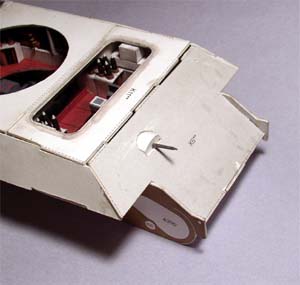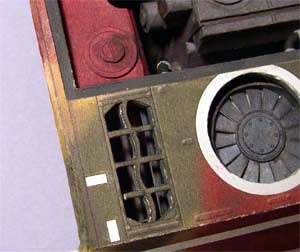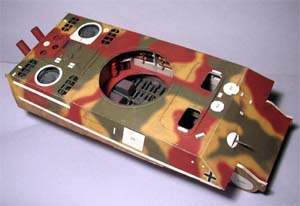 |
After five months of working on the Panther we finally start to work on the exterior of the hull.
Because of all the engine compartment detail I wanted to be able to show off this detail when the model was finished.
I decided to open up the engine compartment; this is not supported in the kit. To get the skin of engine compartment cover I carefully cut the cover from the hull skin. I then placed the hull skin on the partially finished hull (the top plate was not glued in place) and traced the outline of the cover. Measuring in 2 mm from the tracing, I cut the compartment top out of the hull top. The 2 mm lip is needed to support the engine cover on the finished model. We need to save the part we cut out to use as the back of the hull cover. |
 |
Now we glue the hull top in place and we get a surprise, as you can see the front glacis plate did not completely mate up to the top of the hull and we have a .75 mm gap. I'll take the blame for the gap in my rush to glue the glacis plate in place I did not check the over all fit with the top of the hull. After several trial fits of the hull skin over the hull I was satisfied that this gap would not be a problem. The hull top skin is one large piece that covers the top of the hull and the two sides of the hull. I used the small grate openings over the engine compartment as my guides for gluing the skin on to the hull. |
 |
When I finished gluing the hull top skin to the hull I found a second surprise there was a 1 mm gap between the top hull skin and the rear hull skin. Oh the joys of paper models my next step is to call my optometrist to get new glasses. To fill this gap I butt glued a strip of 110 Lb. paper to the rear of the top skin and painted the strip with watercolor paint. The results are satisfactory. you can see the added strip in the photo |


Because of the problems I was having with the fit of the skins I decided to stop and trial fit and trim the parts as needed, I also trimmed the hull to enhance the fit of the skins. The trimming and fitting required a considerable amount of time but the results were well worth the time spent.
 |
Now that that we have the all of the hull skins glued in place we can start on the surface detail of the hull. Here we see the rear of the hull with the exhaust stacks in place with the late model spark arresters on the exhaust. The exhaust stacks were made from 16 ga. copper wire bent to shape. Thin strips of paper were glued to the wire to represent the coupling between the exhaust stack and the exhaust manifold on the rear of the hull. |
As I said in an earlier article I am a slow builder, but even for me this build is taking longer then I expected. I had hoped to be half way done by this time. To keep from loosing my interest in the model I make it a point to do something on the model every evening. If all I do is clean up my worktable or cut out one part I know I am moving forward and the model will eventually get finished. If you should tackle a complex model with over 2000 parts my best advice is to work on it nightly and to look at the model as a series of small models and assemblies that can be finished in couple of evenings.
| Return to the Reviews | Halinski PzKpfw V Panther Part4 | Halinski PzKpfw V Panther Part6 |